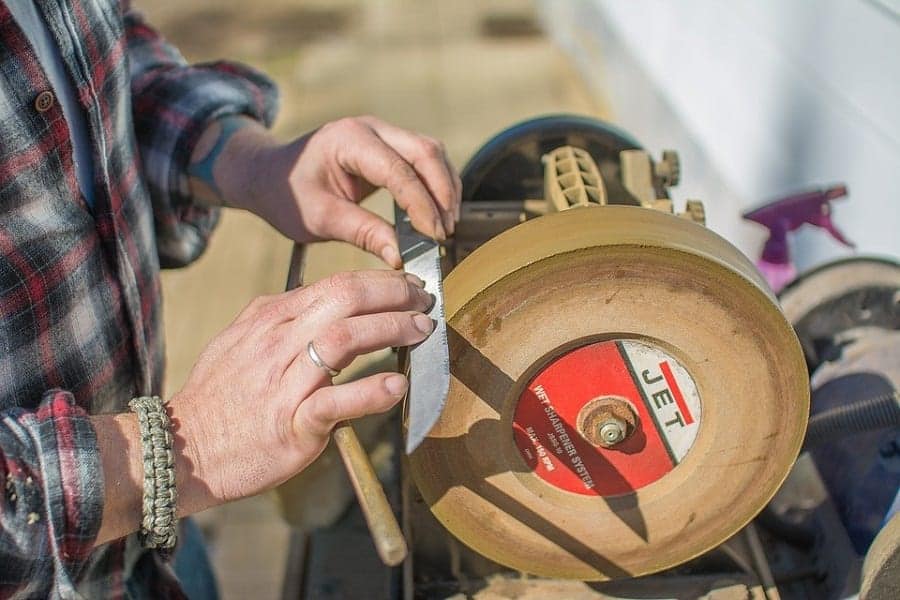Trying to cut a tomato but can’t get even slices?
Chances are you are using a dull knife.
Most of us, at some point in our lives, use a dull knife.
In fact, we use dull knives more often than we would like to admit.
This is a more common scenario in the kitchen where your knife usage is far more frequent than when you are outdoors.
While you may not need a sharp knife for most of your kitchen activities, you will need one as you carve through a roast chicken or try to evenly slice tomatoes.
More importantly, if you are an adventurer who enjoys camping, you will need a sharp outdoor knife along with a sharp kitchen knife.
And contrary to popular belief, a dull knife is far more dangerous compared to a sharp knife.
Here is why: if you are using a dull knife, it will need more pressure to cut.
This increases the chances that a knife may slip and you might get injured.
So making sure that your knives are sharp enough is the best way to ensure that you end up with even cuts of your food and prevent your trip to the ER for stitches.
Here, you will find out all about sharpening a knife, from different methods of sharpening to whether to sharpen the knife yourself or hire a professional.
This basic yet critical technique will allow you to cut quickly, safely and more efficiently. So let’s get started.
Why Do You Need To Sharpen Your Knives?
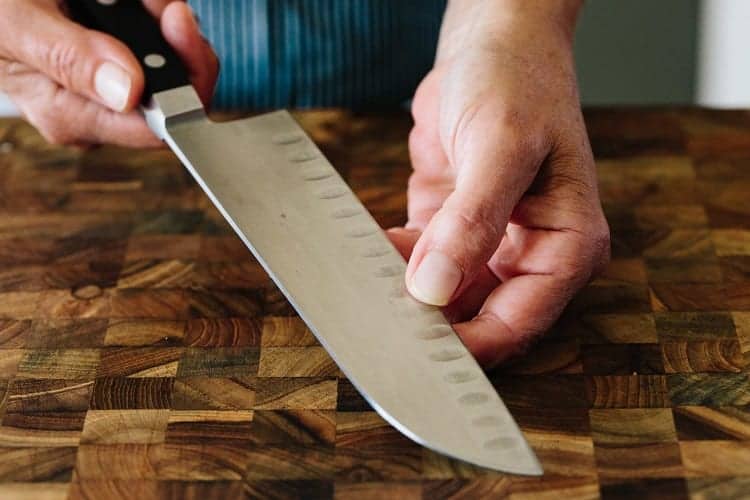
Whether you are in kitchen or outdoors, you need a sharp knife.
Why?
Simply because a sharp knife is a safe one. A sharp knife allows you to cut evenly and neatly.
Whereas you need to exert a lot more force to cut through various foods in case you use a dull knife.
This increases your risk of cuts and injury while cutting.
So the next time you are struggling to cut through beef tenderloin, you better sharpen your knife first.
In the Kitchen
Sharp Knives are Safer
A sharp knife is not only safer but it allows you to cut different types of foods quickly.
Slicing a hard vegetable like carrots or potatoes can be difficult if you use a dull knife but as you sharpen your knife, you can quickly and precisely get the right julienne cut for your carrots or fries.
Even cuts of food items ensure even cooking as well.
Sharp Knives are Efficient
So you need to sharpen your kitchen knife to make sure that you can cut evenly and more efficient.
At the same time, this always you to ensure that you cut safely.
In all, in the kitchen, you need to sharpen your knife so that your food looks and tastes better.
Outdoor Knives
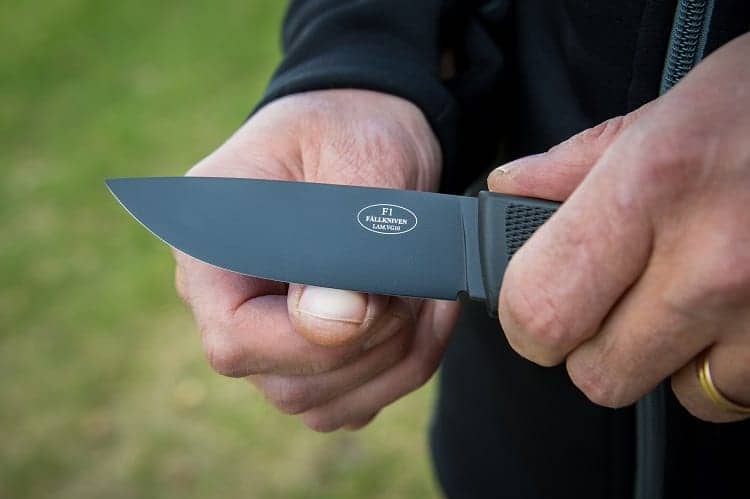
In a survival situation, a dull knife is only as useful as a fork.
No one wants to be in a disaster while camping in the outskirts of the city simply just because of a sloppy knife.
You will need to sharpen your outdoor knife so that you can quickly and neatly cut through the rope, create other tools such as spears and ignite fire at the campsite.
Moreover, you can use the same knife for cutting food items.
Lastly, just like a kitchen knife, a dull outdoor knife is more dangerous compared to a sharp knife.
The reason is the same as mentioned earlier. Using a dull knife requires a lot more force which makes accidents more likely.
And obviously no one can afford a disaster especially on an outdoor trip.
In all, a sharp survival knife will allow you to hunt, gather food, construct shelter, protect against attackers and create other tools which are important for your survival.
With a sharp knife by your side, you can survive even when you do not have any other tools.
How Often Should You Sharpen Your Knives?
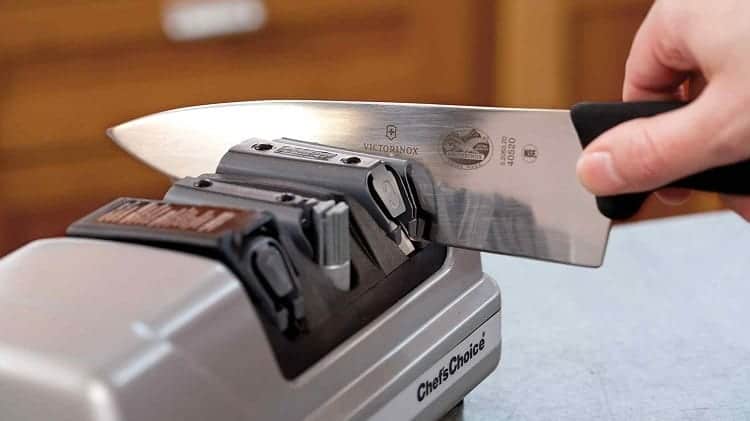
Now that you already know why you need to sharpen different types of knives, it is a good idea to get some information about how often one needs to sharpen the knives.
How often you need to sharpen your knife depends upon various reasons. Let’s take a look at each one of them.
Material of the Knife
The material of the knife is an important determining factor when it comes to the frequency of sharpening a knife.
A knife made up of carbon steel needs to be sharpened after every use.
This however is not the case with regular knives which you use in the kitchen.
A regular kitchen knife is usually made up of stainless steel.
They can continue to be as good as new for up to a month but it is a good practice to sharpen them once every 3-4 weeks and you can get the feeling of a new knife.
Again, there are different types of stainless steel and this can affect the frequency of sharpening the knife.
A knife made up of hard steel requires less frequent honing compared to a knife made up of softer steel.
Use of the Knife
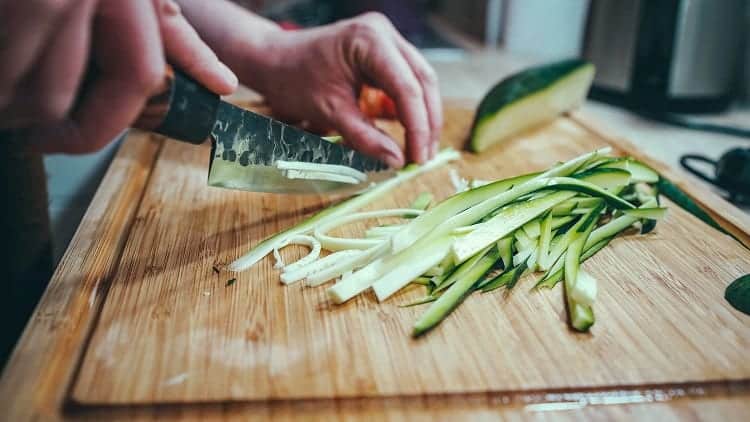
Your use of knife also determines how often you need to sharpen it.
In case of a kitchen knife, you need to sharpen it more frequently compared to a survival knife which you only need to sharpen when you are planning an outdoor trip.
Also, within the kitchen, there are a few knives which are you favorite and you tend to use them more often than others.
So a general rule of thumb is the more frequently used knives need more frequent honing.
This applies to restaurants as well where the use of knives is far more compared to homes.
The Surface on Which You Cut
Knives which are regularly used on cutting board require less frequent honing compared to knives which are used on hard surfaces such as glass, stone or metal.
So if you want to maintain the sharpness of your knife, it is recommended that you always use a wooden or plastic cutting board.
Storage
In case of knives which are not regularly used, how you store them also determines how often you need to sharpen them.
Knives which are stored after they have being completely dried and coated with a thin layer of oil are likely to maintain their sharpness compared to knives which are not stored properly.
So how you store your knives is another key factor in determining how often you need to sharp your knives.
Test for Sharpness
If you are not sure whether you need to hone your knives or not, you can try one of these simple tests at home to check for the sharpness of your knife.
The Paper Test
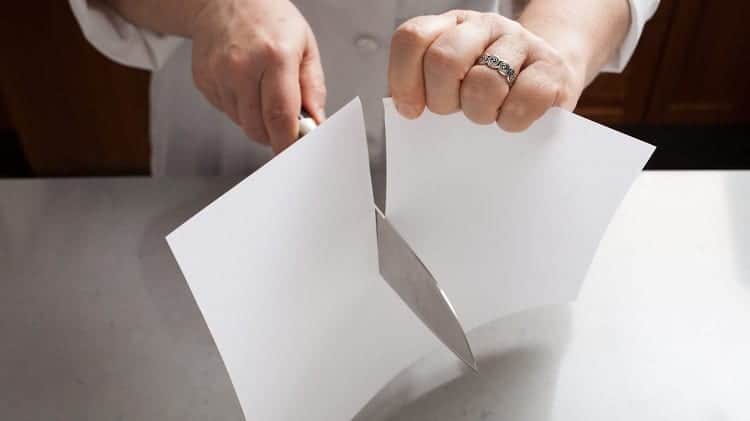
Simply slice a paper with your knife.
If you can do this relatively easily, this means that your knife is sharp enough and does not need honing.
But if you cannot cut through a paper, then your knife is dull and needs honing.
Tomato Test
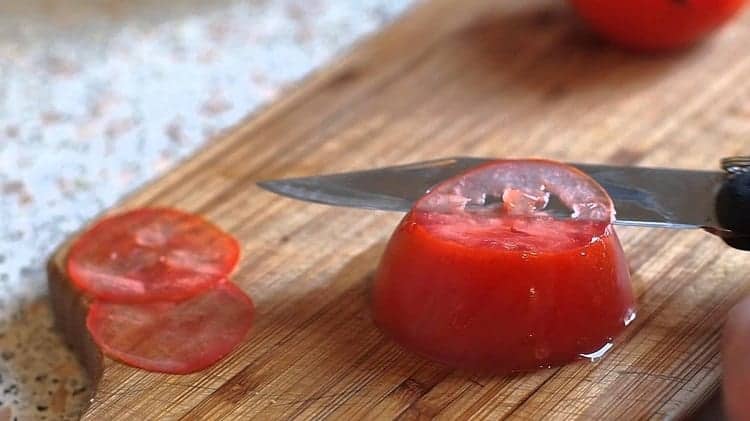
Use your knife to slice a ripe tomato.
If you manage to easily slide through the skin of the tomato, then your knife is sharp and does not need honing.
Now that you know when your knife needs to be sharpened, we can take a look at different methods of sharpening knives.
Different Methods of Sharpening
If you look at the definition of knife sharpening, it is the process of making your knife sharper by grinding against a hard and surface.
This allows the removal or thinning of the outermost layer of the knife so that the interior, sharper part of the knife becomes apparent.
Now there can be many different types of hard and rough surfaces and based on these surfaces, we can classify different methods of knife sharpening.
Some of the methods of knife sharpening are highlighted below.
Rough Sharpening
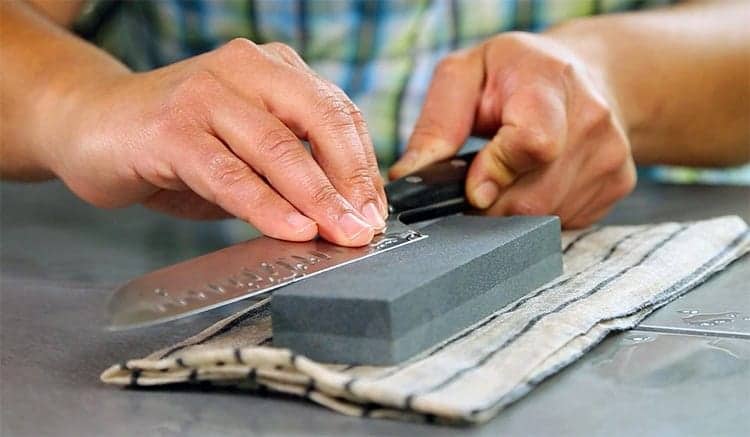
As the name suggest, this method of knife sharpening relies on the use of a rough surface to sharpen the edge of the knife.
Knife sharpening essentially revolves around removing excessive metal off the knife so as you grind your knife against a rough object such as water stone or oil stones.
You can also sharpen the knife against a flexible but rough surface such as a medium grit sandpaper.
Once you have sharpening your knife, you will notice that the edge of knife is more defined and sharper.
Rough Sharpening Your Knife
You don’t need any special equipment such as a grinding wheel for knife sharpening using rough objects.
All you need is a knife which needs to be sharpened and a sharpening tool such as water or oil stone.
Oil stones need to be greased before they can be used for knife sharpening.
Similarly, water stones need to be slightly wet when used for knife sharpening.
Once your stone is ready, place the edge of your knife slightly tilted against the stone (at around 20-25 degree).
Now start moving the knife against the stone as if you are slicing cheese off a block.
Nw do the same in the opposite direction. Repeat the same set of movement on both sides of the knife
Fine Sharpening
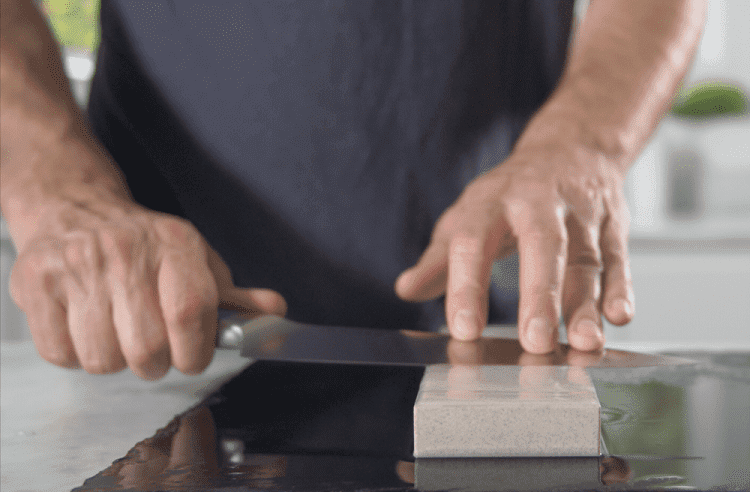
Fine sharpening is almost the same as rough sharpening but requires the use of stones with finer grit.
Usually, different types of stones have different grit on each side.
If you are fine sharpening your knife, all you need to do is to repeat the process of rough sharpening the knife but this time with the finer grot side of the stone.
Straightening
This method revolves around realigning the metal of the knife instead of focusing on the edge of the knife.
Also, straightening does not remove any significant quantity of the metal off the knife.
So technically, this process does not sharpen the knife instead, it rectifies any bends or misalignments in the metal.
How to Straighten a Knife?
A knife can be straightened by applying pressure but the process usually starts with identifying the bend.
You can do this by placing the knife over a counter top, if you notice slightly crooked tip of the knife, this means that the knife means straightening.
All you have to do to straighten a knife is to place your palm on the bend and lift the handle of the knife in the opposite direction.
Reexamine the bend. If it still exists, repeat the process until you get a straightened knife.
As you straighten the knife, you are not removing the metal off the knife. Instead you are simply correcting any bends in the blade.
Polishing (stropping)
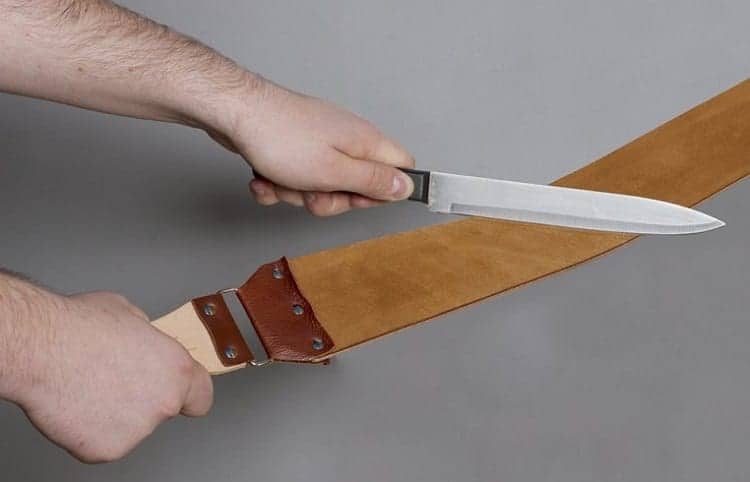
Stropping is not actually knife sharpening but is often used to remove imperfections of the cut.
Very often, stropping is used as the final part of the knife sharpening process and is done of a leather strap.
Essentially, stropping serves various purposes.
- It realigns the edges of the knife.
- Removes excess metal off the knife
- Polishes the surface of the knife
So while it is not exactly same as sharpening, it significantly improves the sharpness of the knife.
However, an already sharp knife is a pre-requisite. Stropping will not enhance the sharpness of a dull knife.
How to Strop Your Knife?
Stropping your knife requires a few tools.
You will need a leather strap and a stropping compound which helps refine the edges of your knife.
Once you have a clean leather strap with stropping compound on it, all you need to do is to place your knife at the desired angle and you are good to go.
Always remember: when stropping, move your knife from the bottom up to the tip and work in a backward motion.
Strop on both sides of the knife to get a perfect polished finish for your knife.
So while stropping can be used to sharpen your knife, it has more of an aesthetic goal.
The idea is to give a mirror like finish to your knife.
An important point to note here is that stropping cannot only enhance the look and sharpness of kitchen knives but is equally effective for survival/outdoor knives.
Steeling
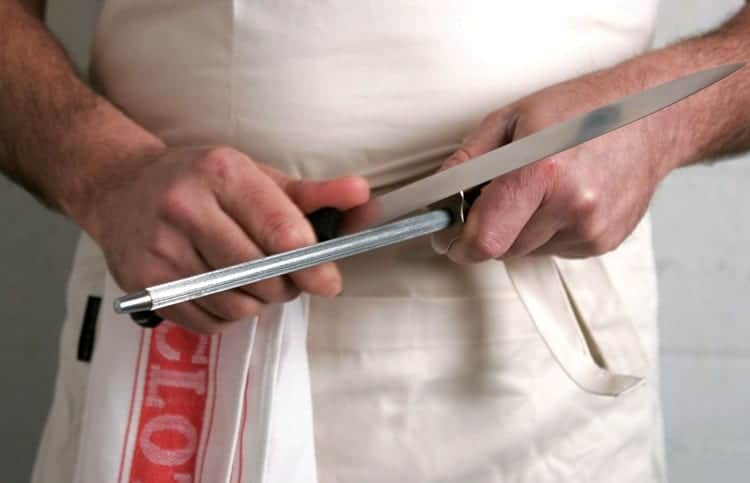
Steeling by definition is the removal of the outer most layer of the metal which is used in the knife but technically it is different from sharpening.
Steeling realigns the edges of the knife which essentially rectifies the causes of dulling such as a rolling edge.
But it is effective for knives which are already sharp enough.
Steeling is done through a steeling rod which is a long cylindrical rod which is used to sharpen a knife that is already in a good shape but only the edges are dull.
But if your knife is already dull, you will need to use other methods for sharpening your knife.
A steeling rod is generally a part of the knife set if you invest in a complete set.
How to Use Steeling Rod?
Not sure how to use a steeling rod? Find out below.
Hold the steeling rod in your left hand (if this is your dormant hand).
In your other hand, hold the knife and apply pressure against the rod with the knife in sweeping motion.
Make sure, you press the entire knife from base to the tip against the rod.
Another safer method is to place the steeling rod perpendicular to a straight surface such as a table.
Then place your knife perpendicular to the rod.
Now rotate your wrist such that the angle between the knife and the rod is approximately 20 degrees.
You can then alternate the sides keeping the angle same.
If you are still not sure, you can watch a lot of online videos to learn how steeling is done.
In all, it can be concluded that steeling is not essentially a sharpening technique.
Instead it is a maintenance procedure which can help keep your knives sharper for longer.
Different Type Of Whetstones For Sharpening
Whetstones, also known as sharpening stones are used to sharpen the edges of a knife.
They come in various shapes and sizes and are made up of different materials.
Each material has a specific size of the abrasive particles within the whetstone.
If you need to sharpen your knife at home, then you need to invest in the right whetstone and you can only do so if you know about different types of whetstones.
Some of the most common types of whetstones are:
Natural Whetstones
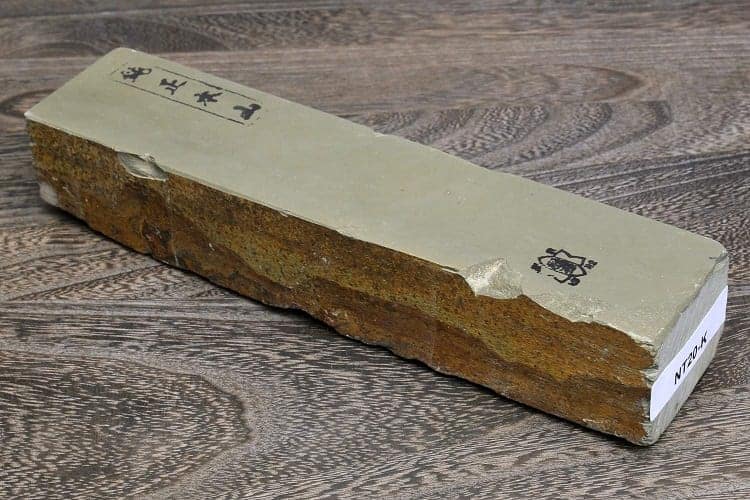
Natural whetstones can be further divided into two categories commonly known as:
Oil whetstones
This type of whetstone is made up of a material called novaculite. They are extremely hard and coarse.
These stones need to be greased before they can be used for knife sharpening.
Water whetstones
Water whetstones are relatively faster at sharpening a knife but they are generally more expensive.
Synthetic Whetstones
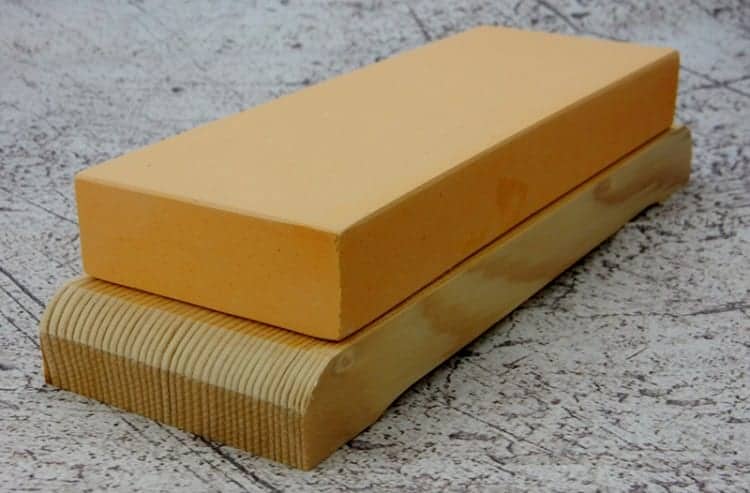
To overcome the shortcomings of natural whetstones, the use of synthetic whetstones is becoming increasingly common.
They are high grit, coarser synthetic whetstones which can sharpen the edge of your knife in no time.
Diamond Whetstones
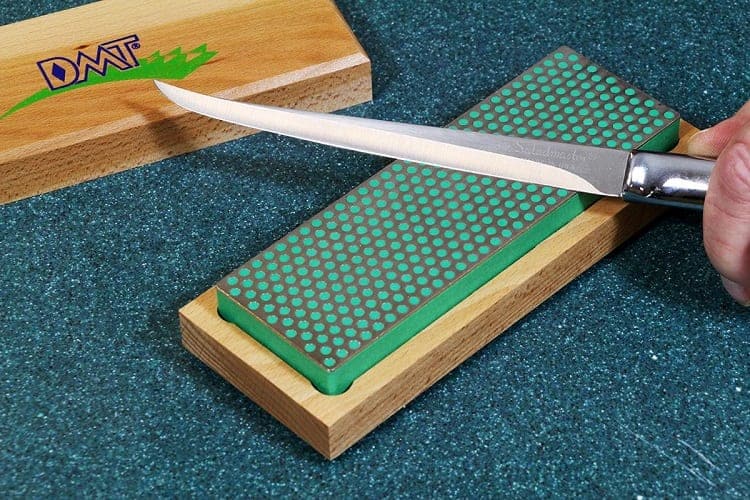
Diamond whetstones are made up of artificial diamond material which allows the knife to get sharpened in no time.
The presence of diamond material makes the surface of the stone more slippery.
This whetstone is most effective for sharpening hard blade knives.
However, since the stone is slippery, you need to be very careful when sharpening your knife.
Due to the slippery surface of the stone, there is a higher chance of getting injured while sharpening your knife.
There are many other types of whetstones which are commonly available in the market.
However, you need to choose the one which best suits your needs.
DIY Sharpening vs. Hiring A Professional
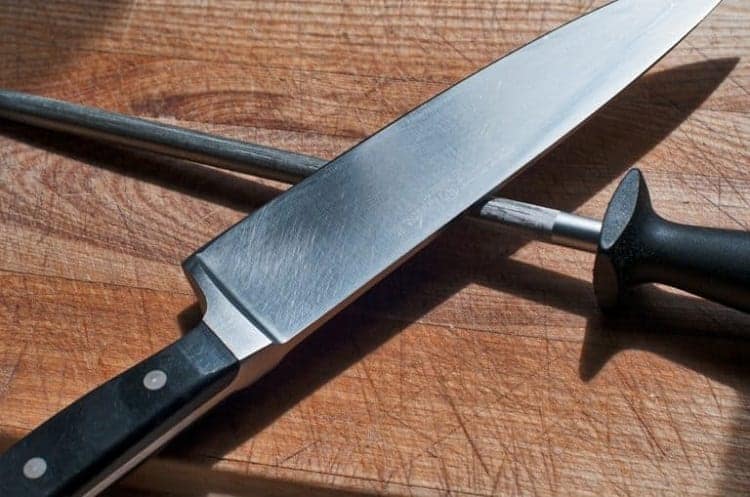
Now that you are fully aware of the techniques used for knife sharpening and the tools you need to sharpen your knife, now is the time to know whether you should sharpen your knives on your own or hire the services of a professional.
The Right Angle
Many people opt for DIY when it comes to knife sharpening.
Yes, knife sharpening appears to be an easy task which just needs a sharpening stone.
Despite the ease and benefits of DIY knife sharpening, remember that DIY is not always the best opt when it comes to knife sharpening.
This is because only professionals know the correct angle at which you need to place your knife against the sharpening stone or an electric sharpener.
This ensures that only the desired amount of metal is removed from the knife.
Number of Knives
Also, the number of knives which need to be sharpened also determines whether you do it yourself or hire a professional.
If you need to sharpen a few regular use kitchen knives, then probably DIY is the best approach but if you have more chef knives and you use them professionally, then hiring a professional is a good idea.
Conclusion
Knife sharpening is an essential culinary technique.
Though you don’t need to sharpen your regular kitchen knives every day, this is something you should do on a regular basis.
How often you need to sharpen your knife depends upon various factors but regardless knife sharpening is a must.
There are various types of sharpening stones which can help you sharpen your knives at home.
But DIY knife sharpening is not always a good idea.
We recommend that you use a combination of DIY and professional knife sharpening so that all different types of knives in your home stay in perfectly sharp shape.

